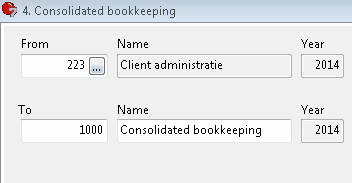A new bookkeeping can be created in menu Bookkeeping.
This function is used for:
2. Making an exact copy of an existing bookkeeping
3. Creating a new bookyear for an existing bookkeeping
4. Creating a consolidated bookkeeping
Log off users:
In the multi-user version Mill7 Pro and Mill7 for Trust it is possible that users are working in a bookkeeping you are trying to create.
For instance when creating an exact copy or a new bookyear.
If this is the case, an information dialog appears with the users that are logged in to this bookkeeping.
These users should be logged off before proceeding.
User rights
When a user creates a new bookkeeping, he automatically receives the rights to open and change that bookkeeping.
Because rights are set per group, all users in that group will also receive these rights.
Users in other groups will not have these rights until granted to them.
After creating a new bookyear the rights for the new year for all user groups will be the same as for the previous bookyear.
To create a new bookkeeping a number of steps must be passed through.
Step 1
Choose a type of bookkeeping.
In the Trust version a new bookkeeping can be designated as a service company.
This is only possible if the active bookkeeping is a service company.
To create a service company, the relation code of the service company must be entered, step 2 will be skipped.
If this code does not exist, it can be created in the relation screen Companies. The company type must be "SRV".
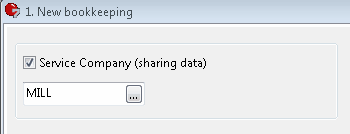
If the new administration is a service company, step 2 is skipped.
Step 2
When creating a new client bookkeeping, three options can be chosen:
1. Create an empty bookkeeping
A new empty bookkeeping will be created. In the next steps a new chart of account must be defined.
2. Copy basis data including relations
A new bookkeeping will be created based on an existing bookkeeping.
All basic data like chart of accounts, daybooks, relations, debtors and creditors will be copied.
3. Copy basic data excluding relations
A new bookkeeping will be created on the basis of an existing bookkeeping.
All basic data like chart of accounts, daybooks will be copied. Relations, debtors and creditors will not be copied.
Step 3
Choose a new unique number for the new bookkeeping. If the chosen number already exists a warning message will appear.
If the General right Create bookkeeping client without debtor not is activated, the number can only be chosen from existing debtor numbers (this option is not working for service companies).
Furthermore the Name and Bookyear of the bookkeeping has to be entered.
In case of a service company there must be a main bookkeeping in the choosen bookyear.
If the new administration is a service company the following steps are skipped. The bookkeeping is created and the service company data is maintained.
Step 4
For the new bookkeeping a number of settings must be set, like Currency, Bookyear from/until and the Period duration.
Step 5
For the chart of accounts three options are presented:
1.Limited chart of accounts
2.Basic chart of accounts for a one-man company
With this option a standard chart of accounts, defined by Mill7, will be created.
This chart of account is in line with the the standard balance code table 11.
This table can be created in Maintenance> Financial > Balance codes > sole proprietorship.
3.Basic chart of accounts for a company
With this option a standard chart of accounts, defined by Mill7, will be created.
This chart of account is in line with the the standard balance code table 12.
This table can be created in Maintenance> Balance codes with the Company template.
Step 6
A number of settings must be defined for the chart of accounts.
Choose the length of the account numbers for the general ledger. This is important because the length cannot be changed afterwards.
When the new bookkeeping is to be based on a limited chart of accounts some ledger accounts must be defined first.
The new bookkeeping can now be created.
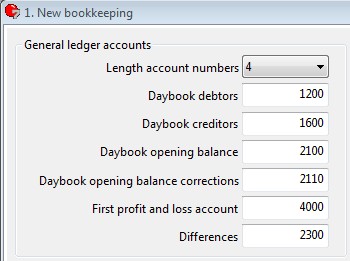
2. Making an exact copy of an existing bookkeeping
Select the bookkeeping to copy and give the new bookkeeping a unique number and name.
The bookyear cannot be changed. It must be equal to the bookkeeping copied. The copy bookkeeping can be created now.
It is not possible to create a copy of a service company.
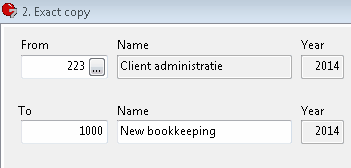
3. Creating a new bookyear for an existing bookkeeping
At the end of the bookyear of a bookkeeping a new bookyear must be created.
For more information see the help topic prolongation bookyear.
It is not possible to create a new bookyear for a consolidation bookkeeping when the consolidation bookkeeping is opened. Open another bookkeeping first and then start the procedure to create a new bookyear.
During the creation of a new bookyear users should be logged of from the relevant administration.
In case of creating a new bookyear for the service companies all users should be logged off as well as Mill7 mobile.Afterwards users can be released and Mill7 mobile can be restarted. This is not done automatically.
There are three options creating a new bookyear.
Option 1. Client/consolidation bookkeeping
Choose the bookkeeping to make a new bookyear for.
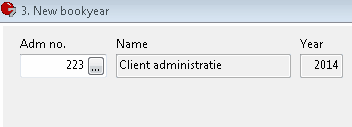
Mill7 automatically shows the last bookyear.
With the button < Create> the new bookyear will be created.
Option 2. All service companies
This option is only available in the Trust version.
With this option all service company bookkeepings will be prolonged to the following year.
Option 3. Current service company
This option is only available in the Trust version.
With this option a new bookyear is created for the opened bookkeeping only.
The option can only be used if
–the opened bookkeeping is a service company and
–the opened bookkeeping is not the main bookkeeping and
–in the following bookyear a main bookkeeping exists but not a bookkeeping for the opened service company.
4. Creating a consolidated bookkeeping
As a basis for a consolidation bookkeeping an existing bookkeeping must be chosen.
All settings of that bookkeeping, like the bookkeeping currency, the period length and the bookyear will be copied to the consolidation bookkeeping.
Give the new bookkeeping a unique number and a name. The bookyear cannot be changed.
The consolidated bookkeeping can now be created.
For more information see the help topic Consolidation.
